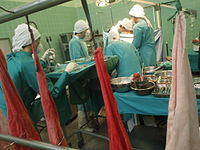
Photo from wikipedia
OBJECTIVE In patients with living donor liver transplantation (LDLT), late-onset complications sometimes develop because of long-term use of immunosuppressive drugs. One of the immunosuppressive drug-related complications is de novo malignancies… Click to show full abstract
OBJECTIVE In patients with living donor liver transplantation (LDLT), late-onset complications sometimes develop because of long-term use of immunosuppressive drugs. One of the immunosuppressive drug-related complications is de novo malignancies resulting in reduced survival. PATIENTS AND METHODS Among 153 patients undergoing LDLT, we retrospectively reviewed the medical records of 97 adult recipients (February 2002 to May 2017), who had been followed-up at our hospital for more than one year after LDLT. The median age was 52 years old (20-70) and the median observational period was 6.9 years (2.4-15.3). RESULTS De novo malignancy after adult LDLT developed in 11.3% (11/97) of patients, including posttransplantation lymphoproliferative disorder (PTLD) (n = 4) (2 in the brain and 2 in abdominal lymph nodes), lung cancer (n = 1), pancreatic cancer (n = 1), gastric cancer (n = 1), laryngeal cancer (n = 1), lower gingival cancer (n = 1), bladder cancer (n = 1), and melanoma (n = 1). Age at cancer diagnosis ranged from 36 to 70 years old with an average age of 61 years. The interval from LDLT to cancer diagnosis was 8.3 years (3.9-12.2). Four patients (36.6%) including PTLD (n = 2), lung cancer (n = 1), and pancreatic cancer (n = 1) died of cancer and all of them were diagnosed with cancer within 10 years after LDLT. Six patients were diagnosed with cancer more than 10 years after LDLT and all of them survived after treatment of cancer. CONCLUSION De novo malignancy was found in 11.3% of LDLT patients, and more than half of this population subset developed tumors 10 years after LDLT. Long-term close follow-up should be performed by taking any kinds of de novo malignancy into consideration.
Journal Title: Transplantation proceedings
Year Published: 2018
Link to full text (if available)
Share on Social Media: Sign Up to like & get
recommendations!